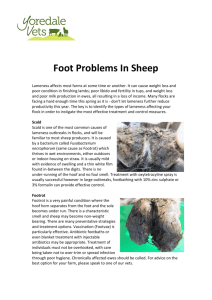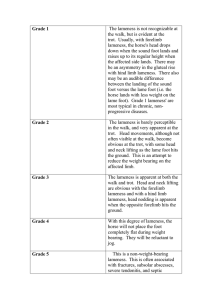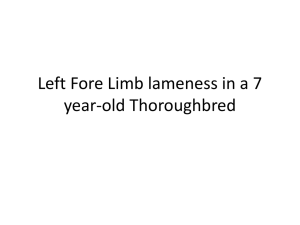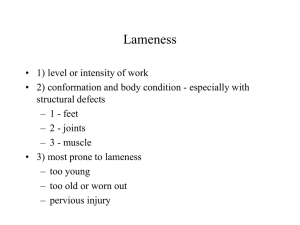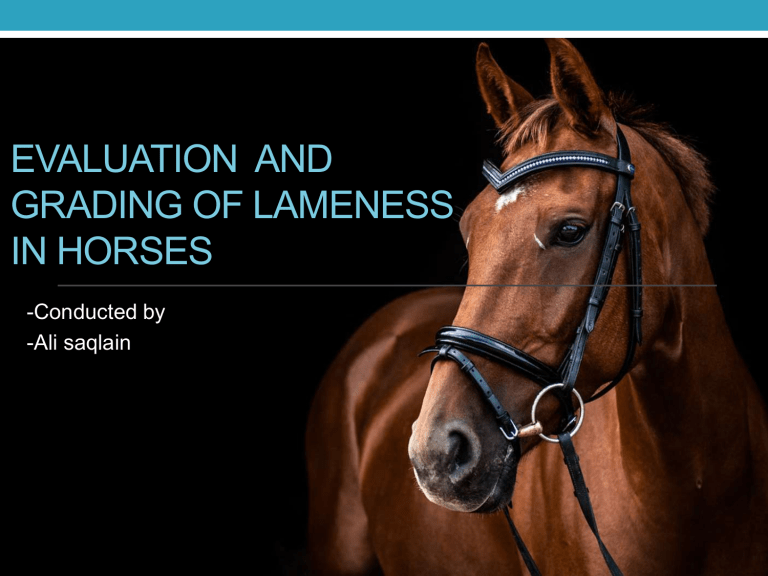
EVALUATION AND GRADING OF LAMENESS IN HORSES -Conducted by -Ali saqlain Possible causes of Lameness • • Physical • Laminitis • Tendon damage. • Ligament injuries. • Bruises or abscesses in the hoof. • Fractures. • Fibrotic myopathy • Poor foot balance. • Back and neck problems. • Degenerative joint diseases (Navicular Syndrome) • Hoof deformities • Nutritional causes • Grain overload (laminitis) • Infectious • Foot rot ( Fusobacterium necrophorum ) refered as Canker. Foremost step for evaluation of Lameness is “History” • Use • Shoeing and diet history • Previous lameness/back problems/other • Current lameness problem including: • Trauma/Duration/Recent management • Previous/current management/medication and response Lameness Evaluation • Observe for changes in symmetry, posture, abnormal foot wear, etc. • Muscles, ligaments, tendons, and joints are palpated and assessed for discomfort or stiffness . • Hoof testers can be used to check pain response. • Local Anesthetics can be used as desensitization will relief from pain temporarily so affected tissue can be diagnosed. Gait analysis • To begin your evaluation • • • • • ,choose a flat ,hard and straight surface Horse should be kept on loose rein to avoid head movement restriction Check for overall gait balance . Check for dragging of leg. Leg should be suspected to be lammed which is not used for putting weight by horse. Check for pelvis movement moving with symmetrical fashion or tilted one side. Lunging Horse is being lunged in a circle on ground to evaluate subtle lameness. It puts more pressure on the inside of leg (front or back) and makes subtle lameness more obvious. Flexion testing • The horse is trotted for a baseline lameness • Then the limbs are individually held in a flexed position as shown • When the leg is released the horse trots away and any exacerbations in lameness are noted • Flexing the joints in this manner may reveal problems that are not otherwise readily apparent Palpation and Manipulation • Hoof examination • Note the size and shape of the foot. • Compare the normal with the abnormal. • Look for any abnormal hoof wear ring formation, heel bulb contraction, • Hoof wall cracks and swellings. • Abnormal hoof growth • long curled-up toes and collapsed heels Club hoof • Hyperextension of Metacarpophalangeal joint (MCP hyperextension) Hoof tester • Hoof testers are keys aspect of the lameness examination in a performance horse. • Hoof tester one end applied on wall of hoof and other end on sensitive portion around apex of frog. • Response • Too much? Foot pain • Too little? Fetlock • Palpate both the dorsal and palmar aspect for any thickening and swelling of the joint capsule. • Palpate the superficial and deep digital flexors for heat, pain or swelling. • Palpate the sesamoid bones and the associated ligaments. Pastern • Palpate this region for heat and or enlargement • Compare any suspected abnormalities with the opposite pastern. • Check for any thickening of the tendons. • Rotate the joint to test for pain in the collateral ligaments. Metacarpus/tarsus • Palpate the tendons on both palmar surfaces for any swelling ,pain or heat. • palpate the length of MC3/MT3 and the splint bones looking for abnormalities. Nerve and joint blocks These techniques are perhaps the most important tools used to identify the location of lameness. Temporarily numbs sensation to specific segments of the limb, one area at a time, until the lameness disappears. This procedure isolates the area of pain causing the lameness. Joint blocks can also help determine whether the condition is treatable or not by intra-articular medications. Distal interphalangeal joint analgesia • Palmer digital nerve block (supplies to Deep digital tendon) • Palmer digital nerve block ( lower branches) • Abaxial (Basisesamoid) Nerve Block Radiographs/X-rays • First choice for imaging bone • Tarsus/hock • By use of Radiography we can detect bone changes when 30% difference from normal has occurred. • Digital radiographs have a wider latitude than conventional radiography. Arthritis 17 Diagnostic Ultrasound First choice for imaging soft tissues Commonly used to image the fetus in human pregnancy Classical sound waves that operate at frequencies far above human hearing, generally spanning 1MHz. Utilizes the transfer and propagation of sound waves into soft tissue to provide an image. Suspensory ligament (Desmitis) Thermography • Thermography is a noninvasive diagnostic imaging technique used to detect variations in bodysurface temperature by measuring emitted infrared radiation can easily reveal the area of inflammation. Magnetic Resonance Imaging (MRI) • MRI provides the ability to see bone • • • • • • pathology and soft tissue structures frequently not seen by other imaging techniques We can see damage (edema) in bone Soft tissue injury Suspensory ligament Deep digital flexor tendon Superficial digital flexor Soft tissues of the foot Grading of Lameness • Grade-1:Lameness is difficult to observe and is not consistently apparent, regardless of circumstances (e.g. under saddle, circling, inclines, hard surface, etc.). • Grade-2: Lameness is not consistently observed at a walk or when trotting in a straight line but consistently apparent under certain circumstances (e.g. weight-carrying, circling, inclines, hard surface, etc.). • Grade-3: Lameness is consistently observable at a trot under all circumstances. • Grade-4: Lameness is obvious at a walk. • Grade-5: Lameness produces minimal weight bearing in motion and/or at rest or a complete inability to move. References : Diagnosis and Management of Lameness in the Horse By Michael W. Ross Adams and Stashak's Lameness in Horses By Gary OBJECTIVE MEASURES OF LAMENESS EVALUATION Kevin G. Keegan DVM, MS, DACVS http://www.equisearch.com/article/the-equine-lameness-exam http://www.centaurbiomechanics.co.uk/gait-analysis/ Horses-Health-Lameness-by-Oliver-Davis Inside a Lameness Exam By Marcia King http://www.vetmed.ucdavis.edu/vmth/diagnostic_imaging/la_ultrasound/activities.cf m Merck veterinary Manual • Conducted by • Ali Saqlain • 2012-ag-2628
